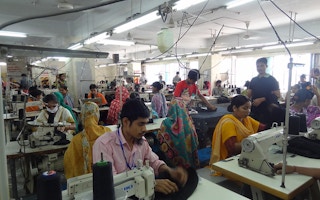It has been two years since #MeToo went viral, and it’s about time the garment industry’s sexual harassment problem got the attention it deserves.
Clothing and footwear brands can do much more to prevent and address gender-based violence in their supply chains, but first they need to confront how badly their inspection or “social auditing” programs fail women.
Clothing brands or factories often bring in social auditors to examine factory working conditions. But social audits primarily rely on in-factory interviews with workers who may fear retaliation, often leaving them ineffective for detecting workplace sexual harassment.
In fact, many auditors I have spoken to have offered useful insights about the limitations of audits. Recently, I spoke to an Indonesian social auditor who shared an anecdote about a garment factory he was inspecting in central Java a couple of years ago. He found a notebook on the factory production floor, and within its pages discovered a woman worker’s anonymous note suggesting she was being sexually harassed.
Clothing and footwear brands can do much more to prevent and address gender-based violence in their supply chains, but first they need to confront how badly their inspection or “social auditing” programs fail women.
The auditor’s attempts to trace the notebook’s owners and encourage workers to speak up were futile, he said, reflecting his general difficulty with documenting sexual harassment in the industry. Workers he interviewed inside factories usually gave stock or terse responses that he felt factory managers coached them to provide.
On the rare occasions that women workers testified about sexual harassment, he said, factory managers would contest it. They asked him what “proof” he had beyond the complainant’s testimony and demanded to know her name. They argued that one worker’s testimony could not justify a “finding” of workplace sexual harassment in the audit report.
In contrast, women workers who speak outside factory premises feel less anxious about retaliation, according to workers themselves, auditors that Human Rights Watch interviewed, and labor advocates.
“
Despite routine social audits by third parties, sexual harassment in the factories was rampant.
For example, the Worker Rights Consortium (WRC), an international labor rights group, found evidence of sexual harassment after conducting off-site interviews with workers for three factories in Lesotho that supplied Levi’s, the Children’s Place, and Kontoor’s. Rola Abirmourched, one of the investigators, reported that despite routine social audits by third parties, sexual harassment in the factories was rampant.
The Lesotho investigation spurred the launch of a promising solution. For over a year, the WRC worked with factory unions and two prominent local women’s rights organisations—the Federation of Women Lawyers in Lesotho, and Women and Law in Southern Africa Research and Education Trust-Lesotho—to design a program addressing gender-based violence and harassment at work. The factory management signed a legally binding agreement with the unions, committing to implement the program.
The agreement creates an independent investigating body to look into complaints of sexual harassment in accordance with Lesotho’s laws. Levi’s, the Children’s Place, and Kontoor’s agreed to partially fund the program for two years.
This effort imparts some important lessons. For one, involving local women’s rights groups is critical, considering the garment industry’s gender imbalance: the majority of union leadership is male even though the garment workers themselves are predominantly women.
It’s also important to recognise the important role that unions and nongovernmental organisations can play in developing training programs, providing legal services, and facilitating access to counseling for gender-based violence and harassment.
The anti-retaliation protections, the legally binding nature of the program, and support from brands were key to the program’s success, said Libakiso Matlho, national director of Women and Law in Southern Africa Research and Education Trust-Lesotho. Programs by women’s rights groups to combat sexual harassment are often undercut by factories’ retaliation or failure to hold perpetrators accountable.
Global brands would be smart to take heed of how the Lesotho agreement incorporates key features of the landmark treaty against violence and harassment at work adopted by the International Labour Organisation earlier this year.
Under the Lesotho agreement, for example, the factories’ policies against gender-based violence and harassment also apply to its suppliers and third-party contractors. The agreement has strong anti-retaliation protections as well.
As garment workers struggle to find dignity at work, global clothing brands should institute strong worker-driven prevention and response programs that bring together credible local women’s rights groups and local unions, instead of depending on social audits. Brands can curb abuse by developing programs that truly empower workers.
Aruna Kashyap is senior counsel in the women’s rights division of Human Rights Watch. This article was originally published on Inter Press Service.









